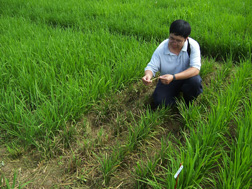This page has been archived and is being provided for reference purposes only. The page is no longer being updated, and therefore, links on the page may be invalid.
| Read the magazine story to find out more. |
|
|
|
|
Examining Rice Genes for Rice Blast Resistance
By Sharon DurhamOctober 17, 2011
U.S. Department of Agriculture (USDA) scientists have characterized the molecular mechanism behind some plants' ability to resist rice blast, a fungal disease that affects cereal grain crops such as rice, wheat, rye and barley and can cause yield losses of up to 30 percent. The fungus has been found in 85 countries worldwide, including the United States.
Agricultural Research Service (ARS) plant pathologist Yulin Jia at the agency's Dale Bumpers National Rice Research Center in Stuttgart, Ark., determined how those molecular mechanisms work and how resistance genes evolved. Jia studies the molecular relationship between rice and the fungi responsible for the diseases rice blast and sheath blight.
ARS is USDA's principal intramural scientific research agency, and this research supports the USDA priority of promoting international food security.
Jia and his colleagues have also mapped two major blast-resistance genes from a rice cultivar from China. Their findings have been reported in the journals Euphytica, Plant Science, and Phytopathology.
A few years ago, Jia visited the International Rice Research Institute (IRRI) in Los Baños, the Philippines, and was able to bring back more than 100 rice lines that contained different genes that confer resistance to the blast fungus. Similarly, IRRI scientists have imported rice germplasm from the ARS collection for their research. Some of this germplasm has shown some resistance to sheath blight strains that occur in their environment, according to Jia.
Genes are constantly changing in order to survive, and over the years the genes in rice and fungi have co-evolved. Resistance is relative to the specific pathogens. For instance, not all humans are immune to flu viruses, because new strains of flu emerge constantly. That is also true for strains of fungi and the rice varieties they infect. So as time goes by, the old resistance genes may not work against the new fungal strains.
Read more about this and other cooperative studies between ARS and international research partners in the October 2011 issue of Agricultural Research magazine.

